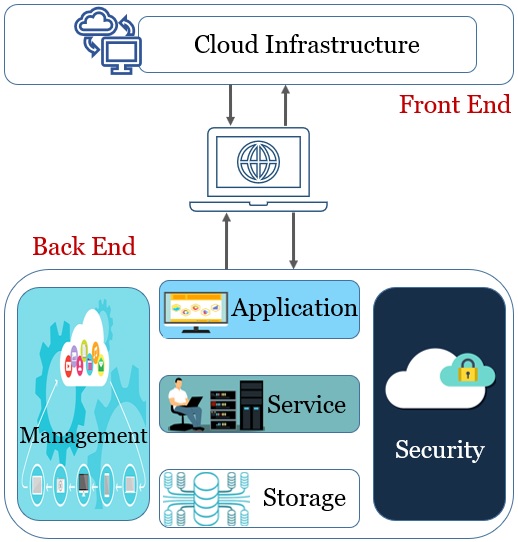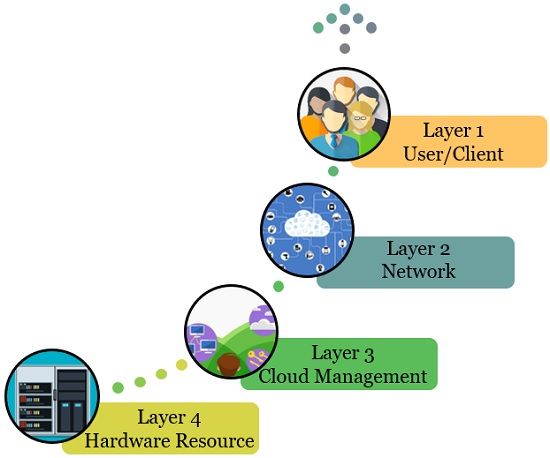Cloud architecture defines the working mechanism of cloud computing. The architecture details about all the components that are essential for the working of the cloud. It helps us in understanding how cloud services are made available to the end users.
In the section ahead, we will be analyzing the cloud architecture in a layered manner. Also, we will discuss the front and the back end of the cloud architecture. We will wind up the content with different kinds of cloud architecture.
Content: Cloud Architecture
- What is Cloud Architecture?
- Cloud Architecture Diagram
- Layered Cloud Architecture
- Types of Cloud Architecture
What is Cloud Architecture?
In a generalized way, we can classify the cloud architecture into two ends i.e. front end and the back end. The front end is the one with which the end users interact. The back end is one with which the cloud provider has to deal.
Both of these ends are connected to each other with the help of the internet. The Internet is the most crucial element of cloud computing as every user needs the internet if it has to access the cloud. Now let us get into the detail of both of these ends in the section ahead.
Cloud Architecture Diagram
The figure below will show you the separation between the front and back end.

Front End
The front end of the cloud architecture consists of applications and interfaces. They are required to access cloud-based services. The main and the only component of the front end is the cloud infrastructure.
The infrastructure consists of hardware resources that have the capability to connect to the internet such as mobile devices, tablets, and laptops. The applications used for initiating access to the cloud are web browsers like:
- Microsoft Edge
- Google Chrome
- Firefox, etc.
Back End
The back end of the cloud architecture consists of several components as discussed below.
- Applications – Provides software or the platform that the client actually wants to access. The clients can access these applications with the help of the resources present at the back end.
- Services – This component is responsible to provide utility to the cloud architecture. The most popular services used among the end users are:
- Storage Applications
- Development Environments
- Web Services
- Storage – This component of the back-end stores and also maintains the client’s data. Such as files, images, audio, video, etc. The client’s data reaches the storage via the internet. Some of the popular cloud storage services are:
- Google Drive
- One Drive
- Dropbox, etc.
- Management – The main task of this component is to establish the coordination between all the components of the cloud architecture.
- Security – It is the primary concern of every technological architecture. It is responsible for providing security to the cloud resources.
Layers of Cloud Architecture
If we consider the users’ access to the cloud then depending on the user’s liberty to access cloud entities, we can classify the cloud architecture into four layers.

Layer 1 (User/ Client Layer)
It is the topmost layer of cloud architecture. The actors of this layer are the end users and the clients. The clients are the devices that can either be a thick client, a thin client, or a mobile device capable of accessing the web application.
Here a thick client is a computer that is capable of working independently. It is the one with adequate processing capability. Whereas, the thin client is the one with the low processing capability. It depends on another device for complete functionality.
At layer 1, the user and client initiate to connect themselves to the cloud. Accessing cloud applications is similar to accessing web applications.
Access to both types of applications requires the internet or other computer networks. Although the internal properties of the cloud application are different from web applications. Hence, we require layer 1 to set up the connection between the user/client and the cloud.
Layer 2 (Network Layer)
Layer 2 or the network layer is responsible for connecting users to the cloud. The absence of a network layer wouldn’t work for the cloud. Because the entire infrastructure of the cloud depends on the connection where it offers the services to the users.
For accessing the public cloud we make connections using the internet. For accessing the private cloud, the connectivity is established using the local area network, i.e. (LAN). Each kind of connection requires a minimum bandwidth specified by the cloud providers.
However, the network layer is beyond the cloud SLA i.e. service level agreement. SLA promises a minimum level of services to cloud customers. SLA does not consider the connection between the cloud and the user for quality of service (QoS).
Layer 3 (Cloud Management Layer)
The layer is responsible for managing the cloud services. It includes the software that manages the working of the cloud. The software used at this layer can be:
- Cloud OS (Operating System)
- Software is responsible for creating an interface between the cloud and its users.
- Software for managing the resources.
The software at the cloud management layer is responsible for:
- Managing resources (scheduling the cloud services, provisioning resources, etc.)
- Optimization (Server consolidation i.e. reducing the total number of servers of the company by making efficient use of server resources, workload consolidation i.e. integrating multiple computational operations onto fewer platforms, storage consolidation i.e. centralizing the data storage and minimizing the time required to access data)
- Internal cloud governance, the network layer comes under close surveillance of SLA. Thus, the operations that take place at this layer will affect the agreement that SLA decide between the cloud users and the providers.
So, a delay in connecting to the cloud would also result in a violation of SLA. In such cases, the providers have to pay penalties. The SLA purviews are both public and private and could for any violation.
Layer 4 (Hardware Resource Layer)
It defines the provision of hardware resources. Layer 4 of a public cloud is the huge data centre. Whereas layer 4 of the private cloud is constructed with a huge collection of hardware resources. These resources are interconnected to each other and are present at a specific location or it may be a high configuration system.
The hardware resource layer comes under the purview of service layer agreements (SLAs). We can even say that the layer governs SLAs. As we have discussed previously that the user must be able to access the cloud services as quick as possible. If there occurs any discrepancy in the provisioning of the hardware resources then the provider might have to pay the penalty.
So, the hardware resource layer of any cloud architecture must consist of data centres with high-speed network connections. The data centre must have a highly efficient algorithm that facilitates data transfer from the data centre to the manager.
A single cloud can have multiple data centres and even multiple clouds can share a single data centre.
So, this is the layered descript of a cloud architecture. Every cloud architecture must strictly flow this layering. However, the separation between layer 3 and layer 4 can be diluted a little depending on the kind of cloud that we have to deploy.
Types of Cloud Architecture
Based on the reason why the particular cloud is deployed we can classify the cloud architecture into the following types.
- Private Cloud
- Public Cloud
- Community Cloud
- Hybrid Cloud
Private Cloud
A private cloud is an internal data centre of an organization. The cloud resources here can only be accessed by the members or employees of the organization. It is not available for public access.
Sometimes the private cloud is just a reconstruction of the existing infrastructure of the organization. The infrastructure is revived by adding virtualization and cloud-like interfaces.
Public Cloud
The public cloud infrastructure can be openly used by the general public. The public cloud can be created, administered, and functioned by any business organization, government or combination of both of them. However, the infra of the public cloud exists on the premises of the cloud provider.
Community Cloud
The owner of the community cloud is several organizations that share a common concern. These organizations are responsible for creating, managing, and operating the community cloud.
Hybrid Cloud
The cloud infrastructure here is composed of two or more distinct cloud architectures such as public, private, or community.
So, this is all about the cloud architecture that provides a clear view of the overall cloud mechanism. It details how the end users are able to access the cloud services. We have discussed the layered cloud architecture along with the front and back end of the cloud architecture.

Leave a Reply